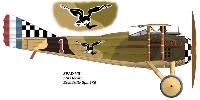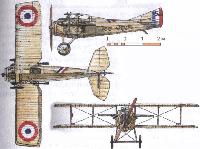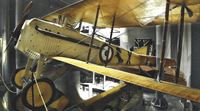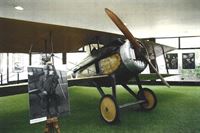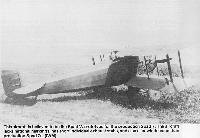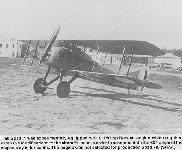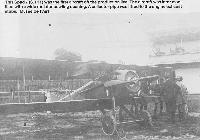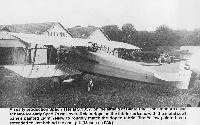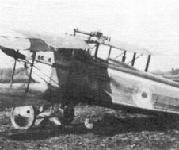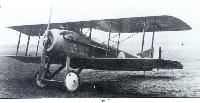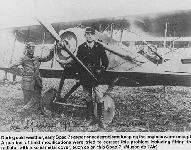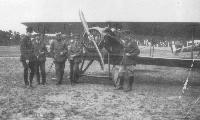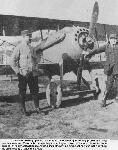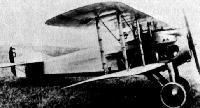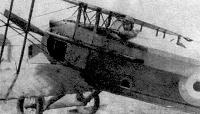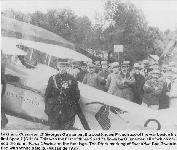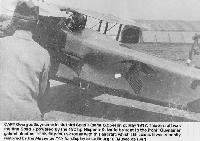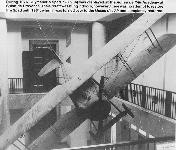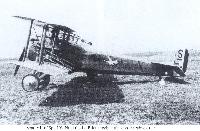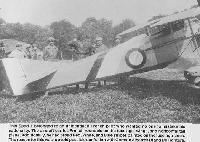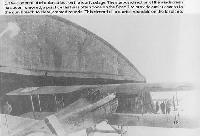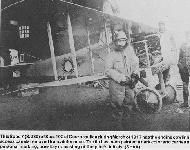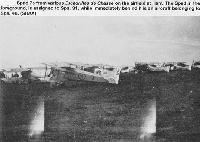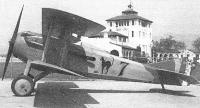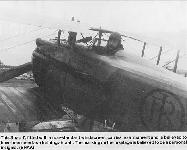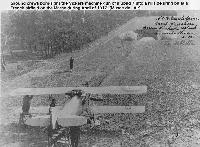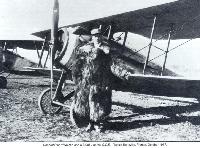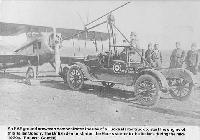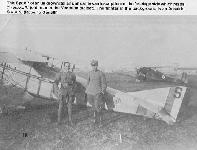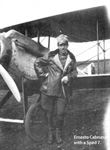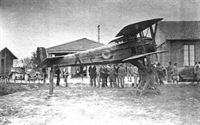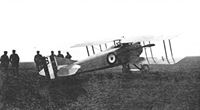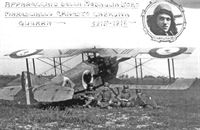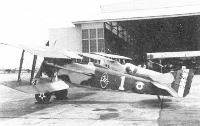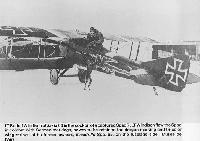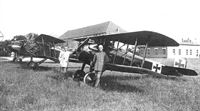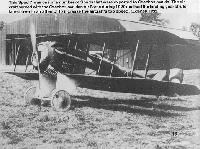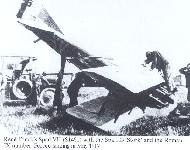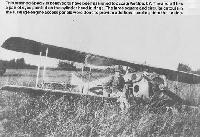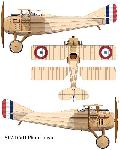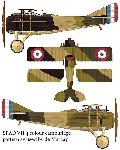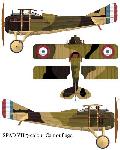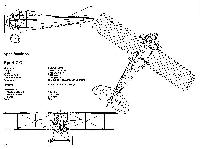
Описание
Страна: Франция
Год: 1916
Истребитель
Варианты
- SPAD - S.VII (Spa 7C-1) - 1916 - Франция
- SPAD - S.XI A.2 - 1916 - Франция
- SPAD - S.XII (Spa 12 C-1) - 1916 - Франция
- SPAD - S.XIII (Spa 13 C-1) - 1917 - Франция
- SPAD - S.XIV / S.XXIV - 1917 - Франция
- SPAD - S.XVI - 1917 - Франция
- SPAD - S.XVII / S.XXI - 1917 - Франция
- Bleriot-SPAD - S.22 - 1919 - Франция
- В.Кондратьев Самолеты первой мировой войны
- А.Шепс Самолеты Первой мировой войны. Страны Антанты
- В.Шавров История конструкций самолетов в СССР до 1938 г.
- J.Davilla, A.Soltan French Aircraft of the First World War (Flying Machines)
- W.Green, G.Swanborough The Complete Book of Fighters
- A.Durkota, T.Darcey, V.Kulikov The Imperial Russian Air Service (Flying Machines)
- O.Thetford British Naval Aircraft since 1912 (Putnam)
- O.Thetford Aircraft of the Royal Air Force since 1918 (Putnam)
- G.Swanborough, P.Bowers United States Military Aircraft Since 1909 (Putnam)
- H.Nowarra, G.Duval Russian Civil and Military Aircraft 1884-1969
- J.Davilla Italian Aviation in the First World War. Vol.3: Aircraft M-W (A Centennial Perspective on Great War Airplanes 75)
- Журнал Flight
-
В.Кондратьев - Самолеты первой мировой войны
"Спад" S VII лейтенанта де Тюрення из эскадрильи SPA 48 французских ВВС, 1917г. "Галльский петух" на борту - эмблема эскадрильи.
-
D.Mechin - Foreign Fronts of the French Air Force 1914-1919 /Aeronaut/
SPAD VII no 283 of Lieutenant Jean de Limur, escadrille N 561, Lido, Winter 1917-1918.
-
W.Green, G.Swanborough - The Complete Book of Fighters
An S.VII of the French Escadrille SPA 81
-
D.Mechin - Foreign Fronts of the French Air Force 1914-1919 /Aeronaut/
SPAD VII no 338 of the N 581 squadron during the summer 1917.
-
D.Mechin - Foreign Fronts of the French Air Force 1914-1919 /Aeronaut/
SPAD VII n°1068 of Lieutenant Frederic Loiseau, escadrille N 561, Venice-Lido, early 1918.
-
D.Mechin - Oriental Adventures of the French Air force 1914-1918 /Aeronaut/
SPAD VII no 1083 of Dieudonne Costes, squadron 507, Salonique-Lembet, May 1917.
-
Сайт - Pilots-and-planes /WWW/
This Spad 7 (serial S.1379) carries the Black Dragon of Spa.65 on the fuselage and is believed to have been flown by ADJ Marcel Henriot
-
D.Mechin - Oriental Adventures of the French Air force 1914-1918 /Aeronaut/
SPAD VII no 7203, Escadrille 523, Vertekop, September 1918.
-
D.Mechin - Oriental Adventures of the French Air force 1914-1918 /Aeronaut/
Profile of the SPAD VII no 11247 manufactured by the company De Marcay, Lt Julien Monier, squadron 504, Galatz (Romania) July 1919. This aircraft, from a batch produced in October 1918, probably never received the markings of the 504 squadron, namely a red Lorraine cross. It probably performed the last mission of the Danube Air Force on July 14, 1919, performing a reconnaissance over the Dniester River.
-
Сайт - Pilots-and-planes /WWW/
SPAD VII Ltn Decaix, Escadrille Spa.150
-
D.Mechin - Oriental Adventures of the French Air force 1914-1918 /Aeronaut/
SPAD VII (serial unknown) from escadrille 506 seen on the Air Park of Salonica on February 1918.
-
D.Mechin - Oriental Adventures of the French Air force 1914-1918 /Aeronaut/
SPAD VII from escadrille 506, summer 1917.
-
D.Mechin - Oriental Adventures of the French Air force 1914-1918 /Aeronaut/
SPAD VII (serial unknown) from escadrille 506, summer 1917.
-
D.Mechin - Foreign Fronts of the French Air Force 1914-1919 /Aeronaut/
SPAD VII (serial unknown) of lieutenant Honore de Bonald (5 victories), escadrille SPA 69.
-
D.Mechin - Foreign Fronts of the French Air Force 1914-1919 /Aeronaut/
SPAD VII of S/Lt Georges Lachmann decorated with his personal question mark. This is most likely the aircraft with which he won his first official victory on September 1, 1917, from the Kamianets-Podolsk airfield.
-
A.Durkota, T.Darcey, V.Kulikov - The Imperial Russian Air Service /Flying Machines/
Spad 7, Escadrille N.581, September 1917. (Georges M. Lachmann)
-
D.Mechin - Foreign Fronts of the French Air Force 1914-1919 /Aeronaut/
SPAD VII (serial unknown) of Capitaine Georges Lachmann, escadrille 590, Bratislava 1919.
-
D.Mechin - Foreign Fronts of the French Air Force 1914-1919 /Aeronaut/
SPAD VII of S/Lt Coudouret, Kamianets-Podolsk, fall 1917.
-
D.Mechin - Foreign Fronts of the French Air Force 1914-1919 /Aeronaut/
Another SPAD VII attributed to S/Lt Coudouret.
-
A.Durkota, T.Darcey, V.Kulikov - The Imperial Russian Air Service /Flying Machines/
Spad 7, Escadrille N.581, September 1917. (Louis F. Coudouret)
-
А.Шепс - Самолеты Первой мировой войны. Страны Антанты
Истребитель SPAD S.VII C1 эскадрильи SPA23 французских ВВС (пилот Максим Леноир; 1917г.)
-
W.Green, G.Swanborough - The Complete Book of Fighters
An S.VII of No 23 Sqn of the RFC at La Lovie in France, July 1917.
-
A.Durkota, T.Darcey, V.Kulikov - The Imperial Russian Air Service /Flying Machines/
Spad 7 #1471, unit unknown, autumn 1917.
-
A.Durkota, T.Darcey, V.Kulikov - The Imperial Russian Air Service /Flying Machines/
Spad 7, 19th Corps Detachment, spring 1917. (Ivan V. Smirnov)
-
A.Durkota, T.Darcey, V.Kulikov - The Imperial Russian Air Service /Flying Machines/
Spad 7, 19th Corps Detachment, summer 1917. (A. Kozakov and E. Shangin)
-
А.Шепс - Самолеты Первой мировой войны. Страны Антанты
SPAD S.VII C1 XIX авиаотряда российской армии (1917г.)
-
W.Pieters - The Belgian Air Service in the First World War /Aeronaut/
SPAD VII, De Leener, 5me Escadrille
-
W.Pieters - The Belgian Air Service in the First World War /Aeronaut/
SPAD VII ‘Sp1’, Thieffry, 5me Escadrille
-
W.Pieters - The Belgian Air Service in the First World War /Aeronaut/
SPAD VII ‘Sp2’, Ciselet, 5me Escadrille
-
А.Шепс - Самолеты Первой мировой войны. Страны Антанты
SPAD S.VII C1 5-й эскадрильи ВВС Бельгии (пилот Ч.Чизелет)
-
W.Pieters - The Belgian Air Service in the First World War /Aeronaut/
SPAD VII ‘Sp5’, Orban, 5me Escadrille
-
W.Pieters - The Belgian Air Service in the First World War /Aeronaut/
SPAD VII ‘Sp7’, 5me Escadrille
-
А.Шепс - Самолеты Первой мировой войны. Страны Антанты
SPAD S.VII C1 19-го дивизиона RFC (1917г.)
-
R.Gentilli - Italian Aviation Units in the First World War. Vol.2 /Aeronaut/ (2)
Spad S.VII S.1390 (or 1398), Ten. Flaminio Avet, 70a Squadriglia, October 1918
-
J.Davilla - Italian Aviation in the First World War. Vol.3: Aircraft M-W /Centennial Perspective/ (75)
Spad VII #1390 (or 1398), Ten. Flaminio Avet, 70a Squadriglia, October 1918
-
R.Gentilli - Italian Aviation Units in the First World War. Vol.2 /Aeronaut/ (2)
Spad S.VII, 70a Squadriglia
-
R.Gentilli - Italian Aviation Units in the First World War. Vol.2 /Aeronaut/ (2)
Spad S.VII, 70a Squadriglia
-
R.Gentilli - Italian Aviation Units in the First World War. Vol.3 /Aeronaut/ (3)
Spad S.VII, 76a Squadriglia, Summer 1917
-
R.Gentilli - Italian Aviation Units in the First World War. Vol.2 /Aeronaut/ (2)
Spad S.VII Erica, 71a Squadriglia, 1917
-
R.Gentilli - Italian Aviation Units in the First World War. Vol.2 /Aeronaut/ (2)
Spad S.7 OCIO!, 71a Squadriglia, 1917
-
R.Gentilli - Italian Aviation Units in the First World War. Vol.2 /Aeronaut/ (2)
Spad S.7, Cap. Ettore Croce, 71a Squadriglia
-
R.Gentilli - Italian Aviation Units in the First World War. Vol.1 /Aeronaut/ (1)
Spad 7 #1673, 77a Squadriglia, serg. Ferrario, Marcon, 1918
-
J.Davilla - Italian Aviation in the First World War. Vol.3: Aircraft M-W /Centennial Perspective/ (75)
Spad VII No.14208, Ernesto Cabruna, 77a Squadriglia
-
R.Gentilli - Italian Aviation Units in the First World War. Vol.1 /Aeronaut/ (1)
Spad 7 #14208, 77a Squadriglia, brig. Cabruna, Marcon, 1918
-
R.Gentilli - Italian Aviation Units in the First World War. Vol.3 /Aeronaut/ (3)
Spad 7 #4707 (S.1544), Ten. Giorgio Pessi, 91a Squadriglia
-
J.Davilla - Italian Aviation in the First World War. Vol.3: Aircraft M-W /Centennial Perspective/ (75)
Spad VII No.4707, Tenente Giorgio Pessi, 91a Squadriglia
-
В.Кондратьев - Самолеты первой мировой войны
Спад S VII, 91-я эскадрилья ВВС Италии, пилот - лейтенант Дж.Парвис, сентябрь 1918г.
-
R.Gentilli - Italian Aviation Units in the First World War. Vol.3 /Aeronaut/ (3)
Spad 7 #4695, Ten. Bartolomeo Costantini, 91a Squadriglia, July 1917
-
J.Davilla - Italian Aviation in the First World War. Vol.3: Aircraft M-W /Centennial Perspective/ (75)
Spad VII #4695, Ten. Bartolomeo Constantini, 91a Squadriglia, July 1917
-
R.Gentilli - Italian Aviation Units in the First World War. Vol.3 /Aeronaut/ (3)
Spad 7 #6364, S.ten. Gastone Novelli, 91a Squadriglia, 1917
-
J.Davilla - Italian Aviation in the First World War. Vol.3: Aircraft M-W /Centennial Perspective/ (75)
Spad VII S6363, S/Ten. Gascone Novelli, 91a Squadriglia, 1918
-
R.Gentilli - Italian Aviation Units in the First World War. Vol.3 /Aeronaut/ (3)
Spad 7, Ten. Fulco Ruffo di Calabria, 91a Squadriglia
-
J.Davilla - Italian Aviation in the First World War. Vol.3: Aircraft M-W /Centennial Perspective/ (75)
Spad VII, Tenente Fulco Ruffo di Calabria, 91a Squadriglia
-
R.Gentilli - Italian Aviation Units in the First World War. Vol.1 /Aeronaut/ (1)
Spad 7 #153, 91a Squadriglia, ten. Ruffo di Calabria, Santa Caterina, 1917
-
А.Шепс - Самолеты Первой мировой войны. Страны Антанты
SPAD S.VII C1 7-й эскадры 3-го дивизиона ВВС Польши (1919г.)
-
R.Gentilli - Italian Aviation Units in the First World War. Vol.3 /Aeronaut/ (3)
Spad 7 2489 flown by the ace is preserved in the Francesco Baracca Museum in his hometown, Lugo fi Romagna.
-
R.Gentilli - Italian Aviation Units in the First World War. Vol.5 /Aeronaut/ (5)
Perfectly restored, Spad 7 S.2489 is now preserved in the Francesco Baracca Museum in Lugo di Romagna.
-
J.Davilla - Italian Aviation in the First World War. Vol.3: Aircraft M-W /Centennial Perspective/ (75)
Spad 7 #2489 in the Baracca Museum. The accepted knowledge in Italy is that Baracca scored one victory in it. In July 1918 this plane was assigned to Lt. Olivero.
-
R.Gentilli - Italian Aviation Units in the First World War. Vol.3 /Aeronaut/ (3)
The historical Museum of the Italian Air Force at Vigna di Valle shows a Spad with the colors of Ruffo. After the war, many fighters were gifted to the top aces, and many of them have survived.
-
J.Davilla - Italian Aviation in the First World War. Vol.3: Aircraft M-W /Centennial Perspective/ (75)
Spad 7 in Italian museum in the markings of Fulco Ruffo di Calabria of the 91a Squadriglia; he was an ace with 20 confirmed victories.
-
R.Gentilli - Italian Aviation Units in the First World War. Vol.3 /Aeronaut/ (3)
Paola Ruffo di Calabria, queen of the Belgians until 2013, visiting the Spad of her father in the Italian Air Force Museum.
-
R.Gentilli - Italian Aviation Units in the First World War. Vol.3 /Aeronaut/ (3)
Cabruna's original Spad is now preserved in the Italian Air Force Museum at Vigna di Valle.
-
R.Gentilli - Italian Aviation Units in the First World War. Vol.5 /Aeronaut/ (5)
An original Spad 7 restored with the colors of Cabruna's plane is preserved in the Officers School of the Carabinieri in Rome. (Courtesy Marco Gueli)
-
R.Gentilli - Italian Aviation Units in the First World War. Vol.3 /Aeronaut/ (3)
Two Spads survive in Italy with the colors of Cabruna: his original one, in the Italian Air Force Museum in Vigna di Valle, and another original Spad, in the Officers School of the Carabineri in Rome.
-
В.Кондратьев - Самолеты первой мировой войны
Российский "Спад" S VII постройки завода "Дукс" на русско-австрийском фронте, 1917 г.
-
В.Кондратьев - Самолеты первой мировой войны
"Спад" S VII завода "Дукс" из состава Костромской авиагруппы Красного воздушного флота, лето 1918 г.
-
A.Durkota, T.Darcey, V.Kulikov - The Imperial Russian Air Service /Flying Machines/
French-built Spad 7 (serial 1471) after being captured by Germans on November 11, 1917. This aircraft has its rudder marked with a red-blue-white band. The fuselage also has a red band running round it.
-
H.Nowarra, G.Duval - Russian Civil and Military Aircraft 1884-1969
Spad S.7 aircraft of No. 1 Fighter Group, the nearest machine serialled S1424. Newly delivered, both lack the skull and crossbones rudder insignia.
SPAD 7s of the Imperial Russian Air Service. First introduced in 1916, the fast, robust SPAD 7 replaced the obsolescent Nieuport fighters in most French fighter squadrons by the end of 1917. The SPAD 7 was also widely used by Allied air services. Via Colin Owers. -
A.Durkota, T.Darcey, V.Kulikov - The Imperial Russian Air Service /Flying Machines/
A Spad 7 preparing for takeoff. Strizhevsky used this type of aircraft to obtain three of his seven confirmed victories.
-
A.Durkota, T.Darcey, V.Kulikov - The Imperial Russian Air Service /Flying Machines/
Pilots of the 9th Fighter Detachment, early spring 1917. Strizhevsky is standing in first row, center. All others unknown.
-
В.Кондратьев - Самолеты первой мировой войны
"СПАД" S VII ВВС РККА. 1920 год.
-
A.Olejko - War Wings Over Galicia 1918-1919 /Aeronaut/
A Russian delicacy... In 1919, a SPAD S.VII C.1 captured from the Russians was repaired in the workshop of the Lewandowka airport. The plane was unfortunately crashed during a flight by Lt. Mieczyslaw Garsztka June 10 1919, who died in his crash. (the collection of Lt. Col. Dr. Kopanski)
-
A.Durkota, T.Darcey, V.Kulikov - The Imperial Russian Air Service /Flying Machines/
Spad 7 used by Kozakov and Esaul (Cossack Captain) Shangin. Kozakov flew this machine on several occasions, but never obtained an aerial victory.
-
H.Nowarra, G.Duval - Russian Civil and Military Aircraft 1884-1969
Austrian personnel with captured Spad, 1917. The black skull and crossbones indicate that this was the aircraft of Capt. Kazakov or his deputy, Shangin.
-
A.Durkota, T.Darcey, V.Kulikov - The Imperial Russian Air Service /Flying Machines/
Smirnov with his Spad 7, summer 1917. He scored seven confirmed victories in this aircraft.
-
A.Durkota, T.Darcey, V.Kulikov - The Imperial Russian Air Service /Flying Machines/
Aircraft of the First Combat Air Group lined up in Galicia, April 1917 The first four machines (Nieuport 17, Spad 7, Nieuport 10, and Dux-built Nieuport 17) were used by Kozakov and have rudders decorated with dark skulls on white backgrounds, opposite of other aircraft in the 19th Corps Detachment.
The field of Jezerzany is also occupied by the 1st Combat Group of the Russian Air Force (1st BAG), gathering three fighter squadrons, and led by Captain Alexander Kazakov. While the staff aircraft (the four planes in the foreground) bear a black skull and crossbones on a white background, those of the 19th KAO bear the same skull and crossbones with white reversed colors on a black background. In the background, 6 Nieuports of the 4th KAO can be seen wearing a white six-pointed star on a red background, then, barely visible, the aircraft of the 2nd KAO wearing a yellow ace of spades on a black background, or vice versa.Другие самолёты на фотографии: Nieuport Nieuport-10 - Франция - 1915Nieuport Nieuport-17/21/23 - Франция - 1916
-
H.Nowarra, G.Duval - Russian Civil and Military Aircraft 1884-1969
Spads, Nieuports, 1 1/2 Strutters and Farmans of the Red Air Force.
Другие самолёты на фотографии: Farman F.30 - Франция - 1915Nieuport Nieuport-17/21/23 - Франция - 1916Sopwith 1 1/2-Strutter - Великобритания - 1915
-
A.Durkota, T.Darcey, V.Kulikov - The Imperial Russian Air Service /Flying Machines/
Spad 7 finished in Bolshevik markings. A large number of these machines were delivered to Russia in the summer of 1917, and were quickly taken over by the Bolshevik forces during the civil war.
-
Сайт - Pilots-and-planes /WWW/
This aircraft is believed to be the Spad V, prototype for the production Spad 7. The aircraft lacks national markings, has short individual exhaust stubs, and a smaller windscreen than production Spad 7s
-
Сайт - Pilots-and-planes /WWW/
This Spad 7 was experimentally equipped with a 150 hp Renault engine which required extensive modifications to the aircraft's nose in order to accomodate the 60 angle of the engine's cylinder banks, The engine was not selected for production Spad 7s
-
Сайт - Pilots-and-planes /WWW/
This Spad 7 (S.111) was the first aircraft off the production line. The aircraft was later modified with a wide radiator cowling opening. A collector pipe was fitted to the engine exhaust stubs
-
Сайт - Pilots-and-planes /WWW/
An early production Spad 7 (serial S.1837) on the airfield at Bar-le-Duc. The standard color scheme for early Spad 7s was overall clear dope on the fabric surfaces with the metal cowl panels painted Light Yellow to roughly match the doped fabric. The Yellow painted area extended to just behind the cockpit
-
J.Davilla, A.Soltan - French Aircraft of the First World War /Flying Machines/
SPAD 7. Via B. Millot and Colin Owers.
-
K.Delve - World War One in the Air /Crowood/
The Spad VII was the favoured mount of many of the French aces.
-
D.Mechin - Foreign Fronts of the French Air Force 1914-1919 /Aeronaut/
The SPAD VII of Second Lieutenant Louis Coudouret, probably at Kamienetz-Podolsk between August 12 and November 15, 1917.
Coudouret by the fuselage of his Spad 7, with wheel covers marked with a red and white yin-yang. There is also a name under the cockpit, but it is not discernible. The location is possibly Kamnietz-Padolsk or Volochyst. -
A.Durkota, T.Darcey, V.Kulikov - The Imperial Russian Air Service /Flying Machines/
Coudouret's Spad 7 in Russia during the summer of 1917 with escadrille N.581. Le Prieur rocket tubes are fitted for attacking enemy observation balloons.
-
D.Mechin - Foreign Fronts of the French Air Force 1914-1919 /Aeronaut/
Another SPAD VII of Second Lieutenant Louis Coudouret, touching with his hand the propeller of the aircraft, which was also equipped with tubes for Le Prieur rockets.
Coudouret standing with his Spad 7, possibly at Robrotsche, where the Russian 19th Detachment was stationed, or at Kholotche in preparation for the Kerensky offensive. -
D.Mechin - Oriental Adventures of the French Air force 1914-1918 /Aeronaut/
Lt Miodrag Tomic, pilot of escadrille N 387, surrounded by his mechanics, poses next to his Nieuport 24 no 4408 on the Vertekop field. In the background, the SPAD VII coded "10". (Coll Boris Ciglic)
Другие самолёты на фотографии: Nieuport Nieuport-17bis/24/27 - Франция - 1917
-
D.Mechin - Oriental Adventures of the French Air force 1914-1918 /Aeronaut/
SPAD VII of escadrille 531. The plane does not seem to wear Greek cockades, despite documentary evidence that all the first Nieuports of the unit had blue/white/blue cockades. (Collection Benoit Henriet)
-
D.Mechin - Oriental Adventures of the French Air force 1914-1918 /Aeronaut/
SPAD VII no 1083 of Dieudonne Costes, equipped in May 1917 by the interested party with two additional Lewis machine guns on the wings. (Coll Benoit Henriet)
-
Сайт - Pilots-and-planes /WWW/
This early Spad 7 reveals the single Vickers machine gun, wrap-around windscreen, and early cowling opening. The two teardrop shaped fairings are the covers for the engine cylinder heads and the fairing between the upper wing and the fuselage covered the gravity fuel tank and radiator header tank piping
-
Сайт - Pilots-and-planes /WWW/
During cold weather, early Spad 7s experienced problems keeping the engines warm enough. A number of field modifications were tried to correct this problem including fitting the radiator with a solid metal cover, such as on this Spad 7
-
K.Delve - World War One in the Air /Crowood/
A variety ot Allied aircrew posing in front of a Spad VII. The prototype of this great fighter first flew in April 1916 and it soon entered production. Designed by Louis Bechereau, this was without doubt one of the best fighters of the war.
-
D.Mechin - Oriental Adventures of the French Air force 1914-1918 /Aeronaut/
One of the very first SPAD VII fighters delivered to the Orient Airforce, at the beginning of 1917.
-
D.Mechin - Oriental Adventures of the French Air force 1914-1918 /Aeronaut/
In front of a SPAD VII are standing, from right to left, Sergeant Paul Andrillon, Sous-Lieutenant Alexandres Zannas and Marechal des Logis Maurice Lashermes. (Collection Benoit Henriet)
-
Журнал - Flight за 1918 г.
Some aeroplanes of the Fifth Army of France: SPAD.
-
K.Delve - World War One in the Air /Crowood/
More advanced types were also present - such as this Spad VII.
-
J.Davilla, A.Soltan - French Aircraft of the First World War /Flying Machines/
SPAD 7 of SPA 88 piloted by Marcel Coadou; the escadrille was assigned to GC 18.
-
D.Mechin - Oriental Adventures of the French Air force 1914-1918 /Aeronaut/
Pilots of escadrille 523 in front of a SPAD VII - Lt Pierre Boucher is in the center, in front of the propeller of the aircraft. (Collection Albin Denis)
-
Сайт - Pilots-and-planes /WWW/
The small cowling opening of the Spad 7 caused engine cooling problems during warmer weather. Eventually the opening was enlarged, however, before this was done a number of field modifications were tried, including drilling extra cooling holes in the cowling as on this Spad 7
-
D.Mechin - Oriental Adventures of the French Air force 1914-1918 /Aeronaut/
SPAD VII no 7203 (produced by De Marcay) of escadrille 523 photographed at Vertekop on September 15, 1918. The aircraft is wearing Serbian roundels (Albin Denis Collection)
-
A.Durkota, T.Darcey, V.Kulikov - The Imperial Russian Air Service /Flying Machines/
Lachmann preparing for a mission. The Spad 7's cowl is dark (possibly red), and Le Prieur anti-balloon rocket tubes are attached to the inner struts.
-
K.Delve - World War One in the Air /Crowood/
The Spad VII with its 150 or 180hp Hispano-Suiza engine had a top speed of 119mph (192kph) and was yet another of the superb French fighter designs that appeared from mid 1916 onwards.
The Spad S.7C1 was used by fighter units until 1925. -
Журнал - Flight за 1917 г.
A view of the Spad used by the Lafayette Escadrille.
-
J.Davilla, A.Soltan - French Aircraft of the First World War /Flying Machines/
SPAD 7 of S/Lt. Bayal of SPA 48 which was assigned to GC 18.
-
D.Mechin - Foreign Fronts of the French Air Force 1914-1919 /Aeronaut/
View of a SPAD VII (n°338) of the N 581 squadron probably at Kamienetz-Podolsk, in autumn 1917. As is often the case with French aircraft in Russia, it bears no distinguishing marks. (Coll Albin Denis)
-
J.Davilla, A.Soltan - French Aircraft of the First World War /Flying Machines/
SPAD 7 built by the de Marcay firm
-
J.Davilla, A.Soltan - French Aircraft of the First World War /Flying Machines/
SPAD 7 Nemesis III of SPA 48 piloted by Robert Bajac.
-
J.Davilla, A.Soltan - French Aircraft of the First World War /Flying Machines/
SPAD 7. The five color camouflage scheme can be discerned on the tail surfaces and wing.
-
Сайт - Pilots-and-planes /WWW/
German postcard of a Spad
-
D.Mechin - Oriental Adventures of the French Air force 1914-1918 /Aeronaut/
Photo of the SPAD VII no 1083 of Dieudonne Costes without its wing guns. (DR)
-
D.Mechin - Foreign Fronts of the French Air Force 1914-1919 /Aeronaut/
It was only after the battle of Caporetto, at the end of 1917, when N 561 finally receives some SPAD VII. These models have been in service for more than a year on the French front... The French high command is far from judging the Venice squadron as a priority for its supply of modern aircraft! One of the very first SPADs received, n°283, was appropriated by lieutenant Jean de Limur who decorated it with the Italian version of the Norman motto: Forse che Si, forse che no (maybe yes, maybe no). This is in fact the title of a novel published in 1910 by Gabriele d'Annunzio, a regular visitor to the squadron and himself an aviator. (SHD)
-
D.Mechin - Foreign Fronts of the French Air Force 1914-1919 /Aeronaut/
A landing by Lt. de Limur on the Lido fort shows the other part of the motto, "Forse che no". (SHD)
-
D.Mechin - Oriental Adventures of the French Air force 1914-1918 /Aeronaut/
Maurice Lashermes, Paul Andrillon and Dieudonne Costes pose in front of a SPAD fighter in September 1918 (Benoit Henriet collection)
-
Сайт - Pilots-and-planes /WWW/
Le Grand Chasseur, LT Georges Guynemer, the best known French ace of the war beside his first Spad 7 (S.113). This was the first of three Spad 7s flown by Guynemer, all of which carried the name Vieux Chales on the fuselage. The Stork marking of Escadrille Spa.3 was in Red with White details
-
K.Delve - World War One in the Air /Crowood/
Among the French aces to establish a reputation on Nieuports and Spads was Charles Guynemer. Here he poses with a Spad VII in December 1916.
-
W.Pieters - The Belgian Air Service in the First World War /Aeronaut/
Capitaine Georges Guynemer, Esc Spa3 landed at Les Moeres airfield on 9 September 1917.
-
W.Pieters - The Belgian Air Service in the First World War /Aeronaut/
Capitaine Georges Guynemer, Esc Spa3 landed at Les Moeres airfield on 9 September 1917.
-
Сайт - Pilots-and-planes /WWW/
CAPT Georges Guynemer in his third Spad 7 (serial S.254) on 25 May 1917. This aircraft was the first Spad 7 powered by the 180 hp Hispano-Suiza to be sent to the front. Guynemer gained nineteen of his fifty-four victories with this aircraft, which still exists. It was recently restored by the Musee de l'Air for display at Le Bourget
-
Сайт - Pilots-and-planes /WWW/
During 1976 Guynemer's Spad 7 (S.254) was displayed at the Armee de l'Air Academy at Salon-de-Provence. The aircraft was hung indoors, however, there was no attempt to restore the Spad until 1981, when it was turned over to the Musee de l'Air and completely restored
-
A.Durkota, T.Darcey, V.Kulikov - The Imperial Russian Air Service /Flying Machines/
Spad 7 of escadrille N.3. While in France, Orlov flew this type to obtain his fourth victory.
-
H.Cowin - Aviation Pioneers /Osprey/
Big, brutal and heavy, the SPAD S VII was the aircraft destined to usurp the Nieuport 17 as France's leading fighter. First flown in May 1916, the S VII initially employed a water-cooled 140hp Hispano-Suiza, whose output was progressively coaxed to give 150hp, then 160hp and, ultimately, 175hp, giving the later S VIIs a top level speed of 119mph at 6.560 feet. Although lacking the Nieuport 17's agility, the S VII more than made up this shortfall by virtue of its higher speed and really robust structure, the latter advantage gaining more importance in people's minds coming as it did at a time when the structural weakness of the Nieuport's wings was beginning to create genuine anxiety. The S VIIs armament consisted of a .303-inch Vickers gun synchronised to fire through the propeller arc. Deliveries of the S VII with 150hp engine started in early September 1916, the type going to both the French and RFC squadrons. Of these early S VIIs, some 495 were French-built, while a further 200 were produced under licence in Britain. These were followed by around 6.000 of the improved SVIIbis with the 175hp engine, the S VII eventually serving with many air arms, including those of Belgium, Brazil, Greece, Italy, Peru, Portugal, Romania, Russia and the US expeditionary force. The stork emblem on the SVII seen here identifies it as belonging the the famed Group de Chasse 12 commanded by Felix Brocard.
-
J.Herris - Weird Wings of WWI /Centennial Perspective/ (70)
The Spad 7 also used Le Prieur rockets for a time.
-
Сайт - Pilots-and-planes /WWW/
Spad VII of Spa 103. Note the Le Prieur rocket tubes on the wing struts
-
Журнал - Flight за 1918 г.
Lieutenant Fonck, the very successful French pilot, in one of the machines which have helped him to do such execution.
-
K.Delve - World War One in the Air /Crowood/
Spad VII of les Cicognes at Dunkirk in 1917.
-
D.Mechin - Oriental Adventures of the French Air force 1914-1918 /Aeronaut/
One to the first SPAD VII fighters received by escadrille 506 during summer 1917. The serial number is erased from the tail, but documents show the delivery of SPAD VII no no 1072, 1083, 1099, and 1236 between April and June 1917.
-
Сайт - Pilots-and-planes /WWW/
This Spad 7 belonged to an unidentified French pilot who wanted no one to mistake his nationality. The aircraft carries French roundels on the fuselage, wings, and horizontal tail plane. Additionally, he had broad Red, White and Blue stripes painted on the fuselage sides. The reason for this was to avoid possible confusion with German Albatros D.I and D.II Fighters
-
Сайт - Pilots-and-planes /WWW/
S.154 also carried tri-color stripes on the rear fuselage. The starboard section of the windscreen has been removed, a practice that was often done on the Spad 7 to provide easier access to the gun breech to clear jammed rounds. THis aircraft also carried roundels on the tailplane
-
Сайт - Pilots-and-planes /WWW/
This Spad 7 (S.239) of Spa.102 at Courbeaulieu during March of 1917 has the engine cowling access panels removed for maintenance. The fin has been painted a dark color and carries a personal marking, possibly consisting of the pilot's initials
-
Сайт - Pilots-and-planes /WWW/
LT Frederic Loiseau of N 561 in his Spad 7 (S.1068) at Lido airfield. The nose of this aircraft was White and the area around the cockpit is believed to have been Green, with a shield-like marking bearing Loiseau's initials. The charging Black elephant on the fuselage side was also a personal marking
-
D.Mechin - Foreign Fronts of the French Air Force 1914-1919 /Aeronaut/
Sous-lieutenant Jean Bignon, who won an aerial victory on November 17, 1917, decorated his Nieuport 24bis n°5158 with a magnificent faun playing a flute. In the background is the SPAD VII n°1068 decorated with the Elefante Nero of lieutenant Frederic Loiseau (SHD)
Другие самолёты на фотографии: Nieuport Nieuport-17bis/24/27 - Франция - 1917
-
J.Davilla, A.Soltan - French Aircraft of the First World War /Flying Machines/
This Spad 7 (S.1379) was assigned to Spa.65 and it is believed that the aircraft was assigned to ADJ Marcel Henriot. The diagonal stripes on the fuselage side just behind the winged dragon unit insignia are Red and White
-
J.Davilla, A.Soltan - French Aircraft of the First World War /Flying Machines/
SPAD 7 wearing the Griffin insignia of SPA 65. SPA 65 was assigned to GC 13.
-
J.Davilla, A.Soltan - French Aircraft of the First World War /Flying Machines/
These Spad 7s and 13s of an unidentified French Escadrille de Chasse parked on a forward French airfield are in the process of having the unit insignia painted on the fuselage. In the foreground is a Spad 7 (S.5190) (31905 ???), while behind is a Kellner-built Spad 13 (S.4567) (43629 ???)
Другие самолёты на фотографии: SPAD S.XIII (Spa 13 C-1) - Франция - 1917
-
Jane's All The World Aircraft 1919 /Jane's/
Side View of a Spad Biplane (from a German photograph of a captured example.)
-
H.Cowin - Aviation Pioneers /Osprey/
An SVII of Escadrille SPA 31 that had been forced down behind enemy lines and carries the legend 'Acquired by Jasta 38. 6 April 1917' in German just aft and below the cockpit coaming.
-
Сайт - Pilots-and-planes /WWW/
Spad 7s from various Escadrilles de Chasse on the airfield at Ham. The Spad in the foreground is assigned to Spa.31, while immediately behind it is an aircraft belonging to Spa.48
-
D.Mechin - Oriental Adventures of the French Air force 1914-1918 /Aeronaut/
SPAD VII and Nieuport 27 fighters of the French-Serbian 523 squadron at Novi-Sad in 1919.
Другие самолёты на фотографии: Nieuport Nieuport-17bis/24/27 - Франция - 1917
-
D.Mechin - Oriental Adventures of the French Air force 1914-1918 /Aeronaut/
SPAD VII of escadrille 506 with the mosquito insignia, during the visit of king Alexander of Greece to the Air Park of Salonica on February 07, 1918.
-
D.Mechin - Oriental Adventures of the French Air force 1914-1918 /Aeronaut/
During early 1918, escadrille 506 adopted a unit insignia, a mosquito, a familiar insect more deadly to the French troops than Bulgarian armies.
-
Сайт - Pilots-and-planes /WWW/
This Spad 7, fitted with a non-standard windscreen, carries no armament and is believed to have been used as a training aircraft. The marking on the fuselage is believed to be a personal insignia
-
A.Durkota, T.Darcey, V.Kulikov - The Imperial Russian Air Service /Flying Machines/
This photo, of poor quality because it comes from the magazine "la guerre aerienne illustree", shows the SPAD VII of S/Lt Georges Lachmann landing on August 6, 1917 in Vinitsia (Ukraine) on his way back from the city of Kiev, a step among others in a hectic journey back to his squadron in Kamienets-Podolsk which he finally reached on August 8. His aircraft is decorated with his personal symbol, the question mark, and also carries an additional Lewis machine gun mount on the upper wing, which is a local DIY job as SPADs were not equipped with them. (Coll Albin Denis)
Another view of the question mark insignia on Lachmann's Spad. The Lewis machine gun has been removed from the unusual gun mount and Le Prieur rocket tubes are mounted on the struts. -
A.Durkota, T.Darcey, V.Kulikov - The Imperial Russian Air Service /Flying Machines/
Lachmann with his Spad 7 while at Kamnietz-Padolsk. It was equipped with a single synchronized Vickers machine gun and an upper wing Lewis machine gun rarely seen on a Spad. His personal markings consisted of the dark (red) cowl and the question mark (le point d'interrogation), probably in red, on the fuselage sides. The Le Prieur rocket tubes have been removed.
-
A.Durkota, T.Darcey, V.Kulikov - The Imperial Russian Air Service /Flying Machines/
A Nieuport 17 and two Spad 7s of N.581 preparing for a mission on the Galacian Front during the summer of 1917. The rear Spad with the dark·colored cowl may be Lachmann's.
-
D.Mechin - Oriental Adventures of the French Air force 1914-1918 /Aeronaut/
Fighters of the orient front in Gorgop during June 1918, supporting the offensive of Greek troops against the Serka di egen mountain. The first plane is a SPAD VII from escadrille 506, equipped with two machine guns - a field modification.
-
K.Delve - World War One in the Air /Crowood/
The French fighter units continued to use the Spads and Nieuports to good effect. These Spad VIIs are from SPA97.
-
D.Mechin - Oriental Adventures of the French Air force 1914-1918 /Aeronaut/
Alignment of Nieuport 23 of escadrille 523 in June 1917, now stationed at Vertekop. Two SPAD VII's can be seen on the right. The Nieuports all bear personal symbols, although on several of them a flower seems to be visible (Collection Albin Denis)
Другие самолёты на фотографии: Nieuport Nieuport-17/21/23 - Франция - 1916
-
Сайт - Pilots-and-planes /WWW/
Ground crews bore-sight the Vickers machine gun of a Spad 7 into a hillside firing pit at a French airfield on the Marne during April of 1917
-
W.Green, G.Swanborough - The Complete Book of Fighters
The S.VII illustrated by the photo being a Mann Egerton-built example.
-
O.Thetford - Aircraft of the Royal Air Force since 1918 /Putnam/
Английский "Спад" S VII.
The aircraft illustrated (A8798) is a Spad VII built by the Air Navigation Co of Addlestone, Surrey. -
O.Thetford - British Naval Aircraft since 1912 /Putnam/
The photograph shows a Spad S.7 with a RNAS serial number (N3399).
-
Сайт - Pilots-and-planes /WWW/
Caporal Stuart Walcott and a Spad 7 at the G.D.E., Plessis-Belleville, France, October 1917
-
Сайт - Pilots-and-planes /WWW/
An RAF ground crewman demonstrates the use of a Hucks starter truck to start the engine of this Italian Spad 7. The British demonstrated the Hucks starter to the Italian during the mid-1920s
-
R.Gentilli - Italian Aviation Units in the First World War. Vol.3 /Aeronaut/ (3)
In 1917 the 76a Squadriglia also received a few early production Spad 7s.
-
H.Cowin - Aviation Pioneers /Osprey/
The Italian Military Air Service relied totally on French developed fighters for its front-line equipment throughout the war. Interestingly, this photograph of an Italian operated SPAD S VII also includes a Nieuport 11, another of the French fighters the Italians favoured. However, unlike the Nieuport 11s and 17s that the Italian built under licence, all 197 Italian SPAD S VIIs were purchased directly from France.
-
J.Davilla - Italian Aviation in the First World War. Vol.1: Operations /Centennial Perspective/ (73)
Italian Spad 7 fighters at the front.
-
R.Gentilli - Italian Aviation Units in the First World War. Vol.2 /Aeronaut/ (2)
Another Spad "7" with the insignia "Ocio!!!" (watch out!)
-
R.Gentilli - Italian Aviation Units in the First World War. Vol.3 /Aeronaut/ (3)
Ranza with a Spad 7 with the insignia of an owl; the photo is dated 2 August 1917.
-
R.Gentilli - Italian Aviation Units in the First World War. Vol.3 /Aeronaut/ (3)
A more elaborate skull on the Spad of Ruffo di Calabria.
-
Сайт - Pilots-and-planes /WWW/
This Spad 7 of an unknown Italian unit carries an inscription on the fuselage side which reads T veclo...!!! (old man in the Venetian dialect). The fighter in the background is an Ansaldo S.V.A.5
-
R.Gentilli - Italian Aviation Units in the First World War. Vol.3 /Aeronaut/ (3)
Serg. Luigi Mancini flew with the 102a Squadriglia. Here he is pictured in a post-war photo that is a puzzle, showing a Spad with an insignia, "Cacciatori del Grappa", fighters of Mount Grappa, that refers to the VI Gruppo, 76a and 81a Squadriglie. Behind it, a Spad of 91a Squadriglia.
-
R.Gentilli - Italian Aviation Units in the First World War. Vol.2 /Aeronaut/ (2)
Spad "7" of the 71a Squadriglia with the name "Enrica".
-
R.Gentilli - Italian Aviation Units in the First World War. Vol.3 /Aeronaut/ (3)
Pilots of the 76a Squadriglia with a Spad 7: from the left, Retino, unknown, De Carolis, Olivi, Bonavoglia. The serial is either 4690 or 4696. (Archive Caliaro)
-
J.Davilla - Italian Aviation in the First World War. Vol.1: Operations /Centennial Perspective/ (73)
Spad 7 with small windscreen in 1919. The pilot is Euardo Olivera from Argentina.
-
R.Gentilli - Italian Aviation Units in the First World War. Vol.3 /Aeronaut/ (3)
T.col. Piccio in a Spad 7 with the griffon insignia.
-
J.Davilla - Italian Aviation in the First World War. Vol.1: Operations /Centennial Perspective/ (73)
Italian fighter pilot in his Spad 7.
-
J.Davilla - Italian Aviation in the First World War. Vol.3: Aircraft M-W /Centennial Perspective/ (75)
Spad 7s in Italian service.
-
R.Gentilli - Italian Aviation Units in the First World War. Vol.3 /Aeronaut/ (3)
The Spad 7 of Francesco Baracca with the black horse insignia.
-
R.Gentilli - Italian Aviation Units in the First World War. Vol.3 /Aeronaut/ (3)
Ranza, Costantini, and Novelli with the latter's Spad 7.
-
R.Gentilli - Italian Aviation Units in the First World War. Vol.3 /Aeronaut/ (3)
The Spad of Cabruna, showing his emblem, the shield of the city of Cortona, and little iron crosses on the fuselage deck, marking his victories.
-
R.Gentilli - Italian Aviation Units in the First World War. Vol.2 /Aeronaut/ (2)
Cap. Flaminio Avet in a striped Bleriot-built Spad 7.
-
R.Gentilli - Italian Aviation Units in the First World War. Vol.2 /Aeronaut/ (2)
Another Spad 7 of the 70a Squadriglia with striped fuselage; the pilot is fen. Tacchi Venturi.
-
R.Gentilli - Italian Aviation Units in the First World War. Vol.2 /Aeronaut/ (2)
Line-up of Spads and Hanriots of the 70a Squadriglia with a variety of individual markings.
Другие самолёты на фотографии: Hanriot HD.1 - Франция - 1916
-
R.Gentilli - Italian Aviation Units in the First World War. Vol.2 /Aeronaut/ (2)
A line-up of Spads of the 71a Squadriglia.
-
R.Gentilli - Italian Aviation Units in the First World War. Vol.3 /Aeronaut/ (3)
The Spads of the 77a squadriglia ai Marcon. (Collection Lancellotti)
-
R.Gentilli - Italian Aviation Units in the First World War. Vol.3 /Aeronaut/ (3)
Airplanes of the 91a Squadriglia at Padua during the retreat, November 1917. Baracca's Spad is the last of the line. Among them there are Spads, Hanriots, and Ni.27s of other units.
Другие самолёты на фотографии: Hanriot HD.1 - Франция - 1916Nieuport Nieuport-17bis/24/27 - Франция - 1917
-
J.Davilla - Italian Aviation in the First World War. Vol.1: Operations /Centennial Perspective/ (73)
Spad 7 fighters in the field. A Hanriot is in the background.
Другие самолёты на фотографии: Hanriot HD.1 - Франция - 1916
-
R.Gentilli - Italian Aviation Units in the First World War. Vol.3 /Aeronaut/ (3)
The fighters of the 77a Squadriglia at Aiello.
Другие самолёты на фотографии: Nieuport Nieuport-11/16 Bebe - Франция - 1915Nieuport Nieuport-17/21/23 - Франция - 1916
-
R.Gentilli - Italian Aviation Units in the First World War. Vol.3 /Aeronaut/ (3)
Three different types, Spad, Nieuport 11, and Nieuport 17, of the 77a Squadriglia at Aiello.
Другие самолёты на фотографии: Nieuport Nieuport-11/16 Bebe - Франция - 1915Nieuport Nieuport-17/21/23 - Франция - 1916
-
R.Gentilli - Italian Aviation Units in the First World War. Vol.2 /Aeronaut/ (2)
A line of Spads and a Hanriot of the 71a Squadriglia at Castelgomberto. (Archive Caliaro)
Другие самолёты на фотографии: Hanriot HD.1 - Франция - 1916
-
R.Gentilli - Italian Aviation Units in the First World War. Vol.2 /Aeronaut/ (2)
At the end of the war, Italian fighter squadrons were powerful units, fielding 18 fighters, with the plan of having 36 pilots and 36 planes in 1919; here the 70a Squadriglia with a mix of Spads and Hanriots and, first from the left, a single Balilla.
Другие самолёты на фотографии: Ansaldo A.1 Ballila - Италия - 1917Hanriot HD.1 - Франция - 1916
-
R.Gentilli - Italian Aviation Units in the First World War. Vol.3 /Aeronaut/ (3)
A mixed line of Spads and Nieuports of different models in Macedonia.
Другие самолёты на фотографии: Nieuport Nieuport-17/21/23 - Франция - 1916
-
R.Gentilli - Italian Aviation Units in the First World War. Vol.1 /Aeronaut/ (1)
A large parade was organized on 20 September 1918 at Padua airfield. Behind a first row of three Spads and six SVAs, there are Capronis with different one or two colors camouflage over the wings.
Другие самолёты на фотографии: Ansaldo SVA.2/3/4/5 - Италия - 1917Caproni Ca.1 - Ca.3 (Ca.30 - Ca.36) - Италия - 1914
-
R.Gentilli - Italian Aviation Units in the First World War. Vol.3 /Aeronaut/ (3)
Carlo "Francis" Lombardi in a Spad of the 77a Squadriglia.
-
R.Gentilli - Italian Aviation Units in the First World War. Vol.3 /Aeronaut/ (3)
Baracchini with a Spad; the photo is dated 16 June 1917.
-
J.Davilla - Italian Aviation in the First World War. Vol.1: Operations /Centennial Perspective/ (73)
Italian fighter pilot getting ready to take off in his Spad 7.
-
J.Davilla - Italian Aviation in the First World War. Vol.1: Operations /Centennial Perspective/ (73)
Italian Spad 7 fighter at the front.
-
R.Gentilli - Italian Aviation Units in the First World War. Vol.3 /Aeronaut/ (3)
Cap. Gelmetti with a Spad of the 77a Squadriglia.
-
R.Gentilli - Italian Aviation Units in the First World War. Vol.5 /Aeronaut/ (5)
Ernesto Cabruna with a Spad 7
-
R.Gentilli - Italian Aviation Units in the First World War. Vol.3 /Aeronaut/ (3)
Pilots of the 73a Squadriglia, from the left, Conto, De Biasi, Randi (?), and Beria d'Argentine.
-
R.Gentilli - Italian Aviation Units in the First World War. Vol.2 /Aeronaut/ (2)
An early Spad 7, without shutters for the radiator. The technician wears an arm band indicating that he is a civilian assigned to military service. (Archive Caliaro)
-
J.Davilla - Italian Aviation in the First World War. Vol.1: Operations /Centennial Perspective/ (73)
Italian fighter pilots with a Spad 7 as a background.
-
R.Gentilli - Italian Aviation Units in the First World War. Vol.3 /Aeronaut/ (3)
Pilots of the 77a Squadriglia; third from left is Serafini, fifth Lombardi.
-
J.Davilla - Italian Aviation in the First World War. Vol.3: Aircraft M-W /Centennial Perspective/ (75)
SPAD 7 in Italian markings. The Italians found the SPAD 7 to be particularly useful as a high speed reconnaissance aircraft. Via Colin Owers.
-
J.Davilla - Italian Aviation in the First World War. Vol.1: Operations /Centennial Perspective/ (73)
Two Italian mechanics in front of a Spad 7.
-
J.Davilla - Italian Aviation in the First World War. Vol.1: Operations /Centennial Perspective/ (73)
Italian fighter pilots with a Spad 7 of 77a Squadriglia.
-
R.Gentilli - Italian Aviation Units in the First World War. Vol.3 /Aeronaut/ (3)
Luigi Olivari in front of his Spad, that had the front part of the cowling painted red.
-
J.Davilla - Italian Aviation in the First World War. Vol.1: Operations /Centennial Perspective/ (73)
Spad 7 of the 71a Squadriglia in February 1918.
-
J.Davilla - Italian Aviation in the First World War. Vol.1: Operations /Centennial Perspective/ (73)
Spad 7 of 71a Squadriglia, 1918. The Spad supplemented but did not replace the Hanriot HD.1. It was faster than the HD.1 but less maneuverable, and its armament remained a single synchronized gun. Most Italian fighter pilots prized maneuverability above all other qualities.
-
R.Gentilli - Italian Aviation Units in the First World War. Vol.3 /Aeronaut/ (3)
Spad 7 4691 was delivered to the 91a Squadriglia in the spring of 1917.
-
R.Gentilli - Italian Aviation Units in the First World War. Vol.5 /Aeronaut/ (5)
This Spad 7, S.2489, occasionally flown by Baracca, was exhibited at aviation events after the war.
-
R.Gentilli - Italian Aviation Units in the First World War. Vol.2 /Aeronaut/ (2)
A Spad 7 with a personal insignia, possibly of cap. Ettore Croce.
-
Z.Czirok - Austro-Hungarian Fighter Units of WWI. Volume 1 /Aeronaut/ (1)
Ten. Bacula of 91a Squadriglia, the witness of Scaroni's air victory on 21st June 1918. (Roberto Gentilli)
-
R.Gentilli - Italian Aviation Units in the First World War. Vol.2 /Aeronaut/ (2)
A Spad 7 of the 71a Squadriglia, maybe the one of ace Antonio Amantea. (Archive Paolo Monti)
-
R.Gentilli - Italian Aviation Units in the First World War. Vol.3 /Aeronaut/ (3)
Spad "Paquita" of the 73a Squadriglia had as emblem a prancing lion with his paw over a German spiked helmet.
-
J.Davilla - Italian Aviation in the First World War. Vol.1: Operations /Centennial Perspective/ (73)
Italian Spad 7 with onlookers.
-
R.Gentilli - Italian Aviation Units in the First World War. Vol.5 /Aeronaut/ (5)
In the spring of 1918 Cabruna had the shield of his hometown, Tortona, painted on his Spad. This airplane was exhibited at Genoa in 1919, then in Tortona, in Milan in 1934, and is now in the Italian Air Force Museum.
-
R.Gentilli - Italian Aviation Units in the First World War. Vol.2 /Aeronaut/ (2)
French-built Nieuport 17 3123 and a Spad of 71a Squadriglia at Villaverla. The pilot is the gallant serg. Francesco Tola, who earned two Silver Medals.
Другие самолёты на фотографии: Nieuport Nieuport-17/21/23 - Франция - 1916
-
R.Gentilli - Italian Aviation Units in the First World War. Vol.5 /Aeronaut/ (5)
SVA 6827 of the 1a Sezione at Sovizzo, together with Spads of the 71a Squadriglia.
Другие самолёты на фотографии: Ansaldo SVA.2/3/4/5 - Италия - 1917
-
W.Pieters - The Belgian Air Service in the First World War /Aeronaut/
SPAD VII ‘Sp2’ of Ciselet, 5me Escadrille.
-
W.Pieters - The Belgian Air Service in the First World War /Aeronaut/
S/Lt Charles Sidi Ciselet, 5me Esc, was severely wounded in a 5 vs 1 combat on 23 September 1917. He would not recover before the end of hostilities.
-
W.Pieters - The Belgian Air Service in the First World War /Aeronaut/
SPAD VII, Sp4, of 5me Escadrille de Chasse.
-
W.Pieters - The Belgian Air Service in the First World War /Aeronaut/
SPAD VII, Sp7, with wet feet.
-
W.Pieters - The Belgian Air Service in the First World War /Aeronaut/
SPAD VIIs Sp7 & Sp5 flanked by an unknown SPAD. In the background can be seen at least three Nieuport N23s.
Другие самолёты на фотографии: Nieuport Nieuport-17/21/23 - Франция - 1916
-
W.Pieters - The Belgian Air Service in the First World War /Aeronaut/
S/Lt Edmond Thieffry, 5me Esc, received a SPAD SVII in August 1917 and scored three victories within 10 days, bringing his total to nine.
-
W.Pieters - The Belgian Air Service in the First World War /Aeronaut/
S/Lt Edmond Thieffry, 10me Esc, was shot down and taken prisoner on 23 February 1918. He was Belgium’s top scoring ace with 10 victories at that moment.
-
W.Pieters - The Belgian Air Service in the First World War /Aeronaut/
41-year-old S/Lt Rene Vertongen, test pilot at Calais-Beaumarais, disappeared over the Channel on 1 February 1918, flying a HD 1 to the front. He washed ashore in April.
-
W.Pieters - The Belgian Air Service in the First World War /Aeronaut/
The nose of Sous-Lieutenant Edmond Thieffry’s SPAD XIII (SPAD VII ???), with white and red cowling. Thieffry was shot down and taken prisoner in this aircraft on 23 February 1918.
-
W.Pieters - The Belgian Air Service in the First World War /Aeronaut/
S/Lt Edmond Thieffry scored his 10th & final victory on 16 October 1917.
-
W.Pieters - The Belgian Air Service in the First World War /Aeronaut/
S/Lt Albert Van Cotthem, test pilot at Calais-Beamarais, scored his only victory on 18 March 1918.
-
W.Pieters - The Belgian Air Service in the First World War /Aeronaut/
S/Lt Bob De Leener, 10me Esc, scored his only victory by downing the Ruyterhoek balloon on 16 September 1918.
-
W.Pieters - The Belgian Air Service in the First World War /Aeronaut/
Adjudant Teddy Franchomme was transferred to the Pilot School where he saw out the war, but not before he had flown a Spad VII at the front.
-
W.Pieters - The Belgian Air Service in the First World War /Aeronaut/
Adjt Edmond Weekers, 10me Esc, cooperated in the shooting down of a Drachen-bailoon on 30 May 1918, but was not credited.
-
M.Dusing - German & Austro-Hungarian Aero Engines of WWI. Vol.1 /Centennial Perspective/ (64)
SPAD 7 of SPA 124 (better known as the Lafayette Escadrille) at Ham in April 1917 with a Nieuport in the background.
The Spad VII was made possible by introduction of the Hispano-Suiza V-8, initially of 140 hp, later with 150 hp, then 180 hp. These versions of the engine did not have reduction gears. This one served with the Lafayette Escadrille. The Spad VII was fast, fairly maneuverable, and robust; its shortcoming was the standard armament of a single synchronized machine gun.Другие самолёты на фотографии: Nieuport Nieuport-17/21/23 - Франция - 1916
-
Журнал - Flight за 1917 г.
Edward F. Hinckle, of the Lafayette Escadrille, standing in front of the first aeroplane to carry the American flag over the French lines.
-
Сайт - Pilots-and-planes /WWW/
LT Rudolf Windisch of Jasta 66 in the cockpit of a captured Spad 7. LT Windisch flew the Spad in combat with German markings, however, he retained the dragon marking and tri-color wing stripes of its former owners, Escadrille Spa.65, on the fuselage side
-
J.Herris - Halberstadt Aircraft of WWI. Volume 2: CL.IV-CLS.I & Fighters /Centennial Perspective/ (45)
This is a Halberstadt D.III at Jastaschule I at Famars airfield near Valenciennes, along with an Albatros D.III. The Spad was one of a whole flight of captured Allied aircraft at the Jastaschule, something of an aggressor squadron. The man on the left is Hptm. Martin Zander, the commander of the school. Zander (five victories) had been pulled from his command of Jasta 1 to take over the new school when it was formed in late November 1916. The man on the right with the big ears is Oblt. Erich Hahn, one of Zander's former pilots at Jasta 1. Hahn appears to have merely been visiting as he was not on the staff of the Jastaschule. Hahn (six victories) commanded the new Jasta 19 until his death on 4 September 1917.
Другие самолёты на фотографии: Albatros D.III - Германия - 1916Halberstadt D.II/D.III - Германия - 1916
-
J.Herris - Halberstadt Aircraft of WWI. Volume 2: CL.IV-CLS.I & Fighters /Centennial Perspective/ (45)
From left, an Albatros D.III, a Halberstadt D.III, and a Spad 7 at Jastaschule I at Famars airfield near Valenciennes. The Albatros D.III is Hptm. Martin Zander's personal machine. It is marked with the letter 'Z' on the bottom wing undersurfaces and is faintly seen on the original image.
Другие самолёты на фотографии: Albatros D.III - Германия - 1916Halberstadt D.II/D.III - Германия - 1916
-
J.Herris, J.Leckscheid - Fokker Aircraft of WWI. Vol.5: 1918 Designs Part 2: D.VII & E.V/D.VIII /Centennial Perspective/ (55)
A lineup of Jasta 6 Fokker D.VII fighters apparently taken at Beugneux airfield. Kirschstein's plane heads the lineup, the usual position for the aircraft of the officer in charge, indicating the photo was snapped on or after 10 June, when he took over command of the Staffel. Parked next to it is a captured, all-white Spad VII still carrying the unit marking of Esc. Spa. 62, its original owner. (Bruno Schmaling)
Другие самолёты на фотографии: Fokker D.VII / V11 / V18 / V22 / V24 - Германия - 1917
-
W.Green, G.Swanborough - The Complete Book of Fighters
A Czechoslovak Army S.VII photographed at Cheb in Western Bohemia during 1920-21.
-
D.Mechin - Foreign Fronts of the French Air Force 1914-1919 /Aeronaut/
French planes given to the young Czechoslovakian air force - SPAD fighters and a Salmson 2A2 at the center of the photo, even if this two seater was not put into service against the Bolsheviks Hungarians.
Другие самолёты на фотографии: Salmson Sal.2 - Франция - 1917
-
Сайт - Pilots-and-planes /WWW/
This Spad 7 was one of a number of Spads that were exported to Czechoslovakia. The aircraft served with the Czechoslovakian Air Force during 1920 and had the landing gear struts faired over in an attempt to increase the aircraft's top speed
-
D.Mechin - Foreign Fronts of the French Air Force 1914-1919 /Aeronaut/
Three French pilots pose in front of a SPAD VII delivered to the Romanian aviation, decorated with the name Marasesti - the famous Romanian battle of year 1917.
-
K.Delve - World War One in the Air /Crowood/
Rugged and dependable, and rated amongst the top three fighters of the War, the Spad VII served on to the end ol the war.
-
Сайт - Pilots-and-planes /WWW/
Rene Fonk's Spad VII (S1461) with the Spa 103 'Stork' and the Roman IX number. Forced landing in May 1917
-
D.Mechin - Oriental Adventures of the French Air force 1914-1918 /Aeronaut/
Costes was the victim of a second de-entanglement on another SPAD VII on September 29, 1917; however, he managed to crash-land south of Salonica. After this double mishap on SPAD, the ace would fly again on a Nieuport fighter and would fly again on SPAD only at the end of spring 1918 (Gallica)
-
J.Herris - Weird Wings of WWI /Centennial Perspective/ (70)
Spad 7 with three guns, two of them on the lower wing. Although a very successful fighter, the production Spad 7 mounted only one synchronized gun, a liability in a time of frequent gun jams. The wing-mounted Lewis guns used ammunition drums that could not be reloaded in combat.
-
J.Davilla, A.Soltan - French Aircraft of the First World War /Flying Machines/
SPAD 7 with wing-mounted machine guns, The purpose of this field modification is not known, but it seems likely that the aircraft was to be used for ground attack. Renaud.
-
Сайт - Pilots-and-planes /WWW/
This crashed Spad 7 is believed to have been assigned to Escadrille Spa.67. The aircraft has a pair of eyes painted on the cylinder head fairings. The large square and circular cutouts in the fuselage engine access panels were done to provide additional cooling air to the engine
-
W.Pieters - The Belgian Air Service in the First World War /Aeronaut/
Adjudant Max Orban is surveying the damage on his SPAD SVII after a rather heavy landing.
-
W.Pieters - The Belgian Air Service in the First World War /Aeronaut/
Although not mentioned in combat orders, Adjt Georges Medaets turned over during a landing at Les Moeres airfield on 10 September 1917.
-
W.Pieters - The Belgian Air Service in the First World War /Aeronaut/
I Sgt Charles Wouters, 10me Esc, suffered engine failure on 12 April 1918. His landing was somewhat clumsy.
-
A.Olejko - War Wings Over Galicia 1918-1919 /Aeronaut/
A Russian delicacy... In 1919, a SPAD S.VII C.1 captured from the Russians was repaired in the workshop of the Lewandowka airport. The plane was unfortunately crashed during a flight by Lt. Mieczyslaw Garsztka June 10 1919, who died in his crash. (the collection of Lt. Col. Dr. Kopanski)
-
D.Mechin - Oriental Adventures of the French Air force 1914-1918 /Aeronaut/
Photo of SPAD VII no 1083 on July 8, 1917, destroyed after a forced landing, when the canvas of its upper plane was detached in flight. (Coll Benoit Henriet)
-
D.Mechin - Foreign Fronts of the French Air Force 1914-1919 /Aeronaut/
These photos of the wreck of SPAD VII seen in May 9,1920, well after the war against Hungary, are very interesting because showing plane of the French ace Georges Lachmann, decorated with his personal marking, the question mark.
-
D.Mechin - Foreign Fronts of the French Air Force 1914-1919 /Aeronaut/
View of Georges Lachmann's SPAD VII on June 26, 1917, or what is left of it, after it crashed into some trees, after having flamed a Russian sausage...! (Coll Jack Herris)
Lachmann's Spad 7 after the crash on June 26, 1917, when due to the early morning fog, he made the mistake of destroying a Russian observation balloon thought to be German. He could not avoid the tree-covered hill directly in front of him. The result was this crash, which Lachmann was fortunate to survive. -
R.Gentilli - Italian Aviation Units in the First World War. Vol.2 /Aeronaut/ (2)
A bad landing for the Spad of serg. Macchi, 25 June 1917.
-
R.Gentilli - Italian Aviation Units in the First World War. Vol.2 /Aeronaut/ (2)
The fatal accident of cap. Croce on 31 May 1918.
-
Журнал - Flight за 1918 г.
"I turned quickly and let the nearest one have a handful of lead, which seemed to deter him somewhat, for he dived away East."
-
Сайт - Pilots-and-planes /WWW/
SPAD VII Plain finish
-
Сайт - Pilots-and-planes /WWW/
SPAD VII 4 colour camouflage pattern as used by de Marcay
-
Сайт - Pilots-and-planes /WWW/
SPAD VII 5-colour camouflage
-
В.Шавров - История конструкций самолетов в СССР до 1938 г.
Схема самолета "Спад-VII"
-
В.Кондратьев - Самолеты первой мировой войны
SPAD S VII
В.Кондратьев Самолеты первой мировой войны
СПАД S VII (Спад-7) / SPAD S VII (Spa 7C-1)
Создание в начале 1915 года относительно легкого и мощного 150-сильного двухрядного V-образного мотора "Испано-Сюиза" сразу подвигло многие французские авиафирмы к разработке истребителей под эту силовую установку. Наиболее удачным оказался проект инженеров фирмы SPAD во главе с Луи Бешеро и Луи Эбремоном.
Аэроплан под индексом S VII впервые поднялся в воздух в апреле 1916-го. Конструкции фюзеляжа и бипланной коробки были аналогичны "Спаду" A1/A2, однако в новой модели Бешеро отказался от передней кабины, сделав самолет одноместным. Фюзеляж, крылья и оперение машины имели деревянный каркас, обтянутый перкалем. Двигатель с восьмиугольным лобовым радиатором, сквозь который проходил вал винта, закрыт алюминиевым капотом характерной округлой формы со съемными боковыми панелями. Задняя кромка крыльев, рулей и элеронов выполнялась из проволоки, а натяжение обшивки придавало ей характерную волнистую форму. Вооружение - один синхронный пулемет "Виккерс".
Самолет показал хорошие скоростные данные, выдающуюся скороподъемность и высокую прочность конструкции, выгодно отличавшую его от "Ньюпора". После успешного завершения испытаний S VII был запущен в серийное производство. В дальнейшем, помимо фирмы SPAD, выпуск машины наладили еще на семи французских авиазаводах ("Де Марсо", "Жануар", "Кельнер", "Соммер", "Режи" и SEA).
Всего во Франции построено более 5600 экземпляров S VII, из них 1800 - на фирме "Де Марсо". Кроме того, 220 штук было выпущено в Англии и около 100 - в России на заводе "Дукс".
Первоначально серийные машины комплектовались 150-сильными "Испано-Сюизами" 8Aa (такие моторы стояли на всех машинах российской сборки), но в дальнейшем на истребители стали устанавливать новые модификации этого двигателя, мощность которых была повышена до 180, а затем и до 200 л.с. Также на поздних серийных экземплярах появились поворотные заслонки жалюзи перед радиатором, регулирующие охлаждение двигателя.
Первые "семерки" поступили на вооружение французских эскадрилий западного фронта в сентябре 1916-го, а к весне следующего года S VII стал основным истребителем французских ВВС. Кроме того, на нем воевали английские, российские, американские, итальянские, греческие и бельгийские пилоты.
По окончании Первой мировой войны "Спад" S VII участвовал еще в нескольких вооруженных конфликтах. Российские "спады" воевали в составе Красного воздушного флота на разных фронтах гражданской войны. Греция применяла свои 28 "спадов" в войне с Турцией 1919-1922 гг. В польско-советской войне "спады" активно использовались обеими сторонами, причем поляки закупили во Франции не менее 18 машин со 180-сильными моторами. Кроме того, 68 "спадов" S VII получила Чехословакия и 12 - Португалия, По несколько штук попало в Югославию, Бразилию и некоторые другие страны.
Описание:












